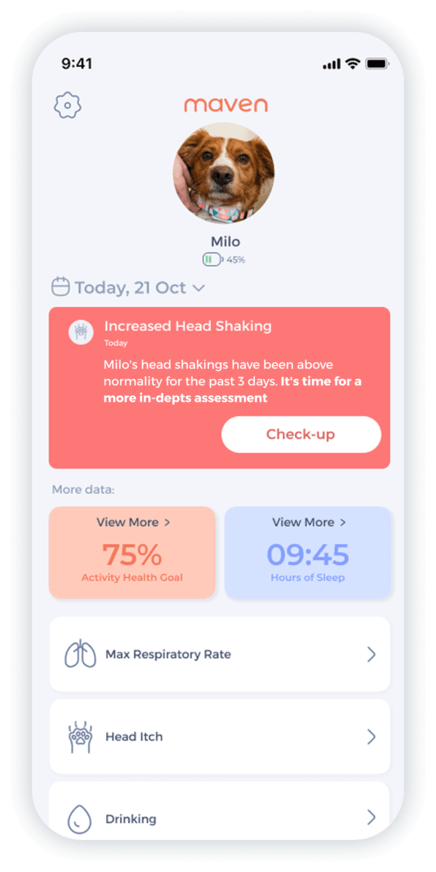Pain Relief for Dogs: All You Need to Know (Vet Verified)
Seeing your pet in distress is heartbreaking. Whether it’s sudden pain from an injury or chronic discomfort from a condition like arthritis, your immediate instinct is to find safe, effective pain relief for dogs. However, canine and human physiology is vastly different. Many over-the-counter drugs safe for you are highly toxic to your dog. So, how can we safely provide pain relief for dogs?
In this vet-guided article, we provide the essential knowledge you need to manage your dog’s pain responsibly, covering how to spot the signs, the veterinary options available, and the importance of professional guidance.
Key Takeaways
- Consult Your Vet First: Never give your dog any medication, especially human painkillers, without a veterinary prescription. Human medications are often toxic to dogs.
- Vet-Approved Meds Are the Only Acceptable Option: Safe pain relief for dogs includes prescription Non-Steroidal Anti-Inflammatory Drugs (NSAIDs), Opioids, other nerve pain medications, and joint supplements.
- Early Detection is Key: Subtle changes in behavior are often the first sign of pain. Monitoring your dog’s daily activity can lead to earlier treatment.
- Use a Dog Health Tracker: a device like the Maven Pet Monitor allows you to detect all subtle signs that indicate pain, even when your dog is suffering in silence.
Signs of Pain in Dogs to Watch For

Dogs are masters at masking pain, so you need to look for subtle, persistent behavioral changes.
Recognizing these signs is the first step toward finding appropriate pain relief for dogs.
Keep an eye out for:
- Changes in Mobility:
- Limping or lameness
- Reluctance to jump, use stairs, or play
- Stiffness, especially after rest
- Behavioral Changes:
- Sudden aggression or snapping when touched
- Whining, whimpering, or excessive panting
- Restlessness or inability to get comfortable
- Increased hiding or withdrawal
- Grooming/Appearance:
- Excessive licking or chewing of a specific body part
- Changes in posture (hunched back, prayer position)
- Decreased appetite or refusal to eat
“I got the Maven sensor for my 14-year-old Chihuahua mix with heart and trachea issues. It gave me back peace of mind – I can track her RRR, BPM, drinking, and activity anytime and know instantly if something’s wrong. Highly recommend!”

★★★★★
Chiara De Luca
Titti
What Can You Give a Dog for Pain?
Only your vet can prescribe or recommend the right medications.
Pain management in dogs is a multi-modal approach, often combining prescription medication with supplements and physical therapies.
The type of medication and dosage depends entirely on your dog’s health status, the type of pain (acute or chronic), and its severity. And only your vet can perform a safe and accurate analysis of these factors.
Pain Meds for Dogs: Vet-Approved Options (Overview)
Veterinarians have a range of safe options for managing dog pain.
Non-Steroidal Anti-Inflammatory Drugs (NSAIDs)
These are the most common pain meds for dogs used to treat mild and moderate pain and inflammation.
- How They Work: NSAIDs target the inflammatory pathway, reducing both pain and swelling.
- Safety Note: These drugs are specifically formulated for dogs and come with strict guidelines. Your vet will often run bloodwork before starting an NSAID and periodically monitor for potential side effects involving the liver or kidneys.
Opioids
Opioids (morphine, fentanyl, and others) are typically used for:
- Severe Acute Pain: Such as post-surgery or major trauma.
- Advanced Chronic Pain: Used as part of a complex, multi-drug protocol.
Other Adjunctive Pain Medications
Vets may use a variety of other medications, often in combination with NSAIDs, to address different aspects of pain:
- Gabapentin/Amantadine: These medications target nerve-related pain, which is often a component of chronic conditions like severe arthritis or spinal issues.
- Monoclonal Antibodies (mAbs): Newer injectables work by targeting Nerve Growth Factor (NGF), a key protein involved in pain signaling, offering relief for osteoarthritis.
Supplements and Natural Therapies
While not a substitute for medication in severe cases, these can be a valuable part of long-term chronic pain management:
- Glucosamine and Chondroitin Sulfate: These nutraceuticals are the building blocks of cartilage and can help support joint health, providing an indirect anti-inflammatory effect.
- Omega-3 Fatty Acids (Fish Oil): High doses have proven anti-inflammatory properties that can help reduce joint pain.
- Physical Rehabilitation: Acupuncture, therapeutic laser, hydrotherapy, and controlled exercise can significantly improve mobility and reduce pain.
Why You Should Never Use Human Pain Meds

The most crucial safety warning is this: do not give your dog human pain medication.
- Acetaminophen (Tylenol): Highly toxic. It can cause severe liver damage and red blood cell destruction.
- Ibuprofen (Advil, Motrin): Extremely toxic. It can lead to stomach ulcers, kidney failure, and neurological damage.
- Naproxen (Aleve): Highly toxic, often causing severe gastrointestinal ulcers and kidney damage.
Dogs metabolize drugs differently than humans do. Even a seemingly small dose of a human NSAID or Acetaminophen can be lethal. If you’ve given your dog any human medication, contact your vet or an emergency animal hospital immediately.
What Can I Give My Dog for Immediate Pain Relief?
If your dog is suddenly showing signs of pain and you cannot reach your vet immediately, the best and safest first-aid is supportive care, not medication.
- Confine your dog to a small, secure area (like a crate or small room) to prevent further injury.
- Ensure they have soft bedding. Use a sling or towel as a gentle harness if they need to be helped outside to potty.
- Apply heat/cold cautiously to help acute swelling (like a recent sprain) for 10-15 minutes.
- Keep trying to reach your vet.
When to See a Vet
You should always consult your vet if you suspect your dog is in pain, but seek emergency care if you notice:
- Sudden inability to walk or bear weight
- Signs of severe distress (loud crying, excessive shaking, collapse)
- Bloody vomit or diarrhea
- Swallowing a foreign object or known ingestion of a human painkiller
“Dogs are experts at hiding pain. Subtle changes in behavior or activity are often the first clues — and that’s where monitoring tools like Maven can really help.” – Joana Babo, DVM, Veterinarian at Maven Pet
How Maven Pet Helps Detect and Track Pain-Related Behavior Changes
A dog’s reluctance to move is often the earliest signal of discomfort. Many owners don’t realize their dog is slowing down until the pain is significant.
This is where proactive digital tools become essential.


Monitor heart rate, respiratory rate, activity & rest, drinking, itch behavior.
The Maven Pet Health Monitor is a wearable pet health tracker that quietly monitors your pet’s daily activity, rest, and behavior patterns.
- Early Detection: The Maven pet monitor detects subtle, significant deviations from your dog’s established baseline, like a 15% decrease in daily movement, a change in sleep duration, or increased nighttime restlessness. These changes are often correlated with the onset or worsening of chronic pain.
- Objective Data for Your Vet: Rather than relying on vague “he seems stiff” descriptions, the Maven monitor provides your vet with objective data through a pet health app connected to the device. This helps your vet more accurately diagnose the issue, assess the current severity of the pain, and track the effectiveness of any prescribed pain meds.
Takeaways Recap
Managing your dog’s pain is one of the most important aspects of responsible pet care.
- Absolutely avoid all human pain medication.
- Only use vet-prescribed, dog-specific pain relief for dogs.
- Use tools like the Maven Pet Health Monitor to catch the subtle, early signs of discomfort and track their response to treatment.
Maven Pet focuses on improving the quality of life of our pets with technology, using artificial intelligence (AI) to enable proactive pet care. By accurately collecting and monitoring pet data 24/7 and flagging any irregularities, Maven Pet empowers pet parents and veterinarians to stay ahead of potential health issues, ensuring the well-being and longevity of our beloved companions.




